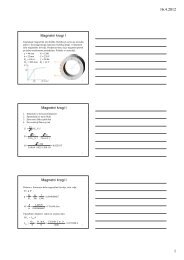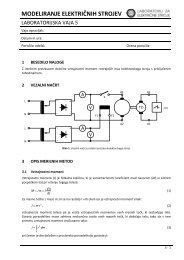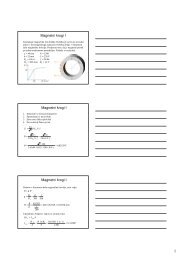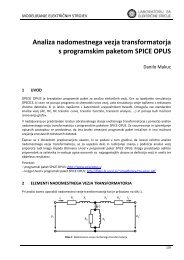Maxwell SV Getting Started: A 2D Magnetostatic Problem - LES
Maxwell SV Getting Started: A 2D Magnetostatic Problem - LES
Maxwell SV Getting Started: A 2D Magnetostatic Problem - LES
Create successful ePaper yourself
Turn your PDF publications into a flip-book with our unique Google optimized e-Paper software.
<strong>Getting</strong> <strong>Started</strong>: A <strong>2D</strong> <strong>Magnetostatic</strong> <strong>Problem</strong><br />
Project Window<br />
The main <strong>2D</strong> Modeler window contains the Drawing Region, the grid-covered area where you<br />
draw the objects that make up your model. This main window in the <strong>2D</strong> Modeler is called the<br />
project window. A project window contains the geometry for a specific project and displays the<br />
project’s name in its title bar. By default, one subwindow is contained within the project window.<br />
Optionally, you can open additional projects in the <strong>2D</strong> Modeler using the File>Open command.<br />
Opening several projects at once is useful if you want to copy objects between geometries. See the<br />
<strong>Maxwell</strong> <strong>2D</strong> online help for more details.<br />
Subwindows<br />
Subwindows are the windows in which you create the objects that make up the geometric model.<br />
By default, this window:<br />
• Has points specified in relation to a local uv coordinate system. The u-axis is horizontal, the vaxis<br />
is vertical, and the origin is marked by a cross in the middle of the screen.<br />
• Uses millimeters as the default drawing unit.<br />
• Has grid points 2 millimeters apart. The default window size is 100 millimeters by 70 millimeters.<br />
Note If a geometry is complex, you may want to open additional subwindows for the same<br />
project so that you can alter your view of the geometry from one subwindow to the next.<br />
To do so, use the Window>New command as described in the <strong>Maxwell</strong> <strong>2D</strong> online help.<br />
For this geometry, however, a single subwindow should be sufficient.<br />
Status Bar<br />
The status bar, which appears at the bottom of the <strong>2D</strong> Modeler screen, displays the following:<br />
U and V Displays the coordinates of the mouse’s position on the screen and allows<br />
you to enter coordinates using the keyboard.<br />
UNITS Drawing units in which the geometry is entered.<br />
SNAPTO Which point — grid point or object vertex — is selected when you<br />
choose points using the mouse. By default, both grid and object points are<br />
selected so that the mouse snaps to whichever one is closest.<br />
Message Bar<br />
A message bar, which appears above the status bar, displays the functions of the left and right<br />
mouse buttons. When selecting or deselecting objects, the message bar displays the number of<br />
items that are currently selected. When you change the view in a subwindow, it displays the current<br />
magnification level.<br />
Toolbar<br />
The toolbar is the vertical stack of icons that appears on the left side of the <strong>2D</strong> Modeler screen.<br />
Icons give you easy access to the most frequently used commands that allow you to draw objects,<br />
change your view of the problem region, deselect objects, and so on. Click an icon and hold the<br />
button down to display a brief description of the command in the message bar at the bottom of the<br />
screen.<br />
For more information on these areas of the <strong>2D</strong> Modeler, refer to the <strong>Maxwell</strong> <strong>2D</strong> online help.<br />
3-4 Creating the Model
















